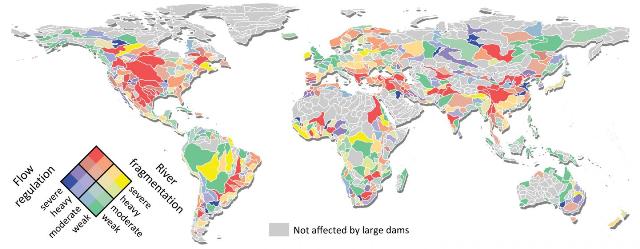Jan 8 2015
When dams are built they have an impact not only on the flow of water in the river, but also on the people who live downstream and on the surrounding ecosystems. By placing data from close to 6,500 existing large dams on a highly precise map of the world's rivers, an international team led by McGill University researchers has created a new method to estimate the global impacts of dams on river flow and fragmentation.
 THIS IS A MAP SHOWING COMBINED EFFECT OF CURRENT AND FUTURE DAMS. (CREDIT: MCGILL UNIVERSITY)
THIS IS A MAP SHOWING COMBINED EFFECT OF CURRENT AND FUTURE DAMS. (CREDIT: MCGILL UNIVERSITY)
Among their findings, published online in Environmental Research Letters: 48% of the world's river volume is moderately or severely affected by dams today - and that figure would nearly double if all dams planned or under construction are completed in the future.
"Over the past 60 years, a myriad of dams have been built either to provide hydroelectric power, or for irrigation purposes, or as flood protection," says Bernhard Lehner, a professor in McGill University's Department of Geography and the research director of the project. "The construction of large dams then slowed down for the last 20 years as we became more aware of their negative effects on people and ecosystems. But now, with fears about how climate change may affect water flows in the future, the goal of creating reservoirs is once more appealing, and dam construction is on the rise."
The new research was made possible by the team's development of a global river map with unprecedented resolution and detail, showing all waterways of the world from small creeks to the largest of rivers, accounting for a cumulative river length of 48.3 million km -- and by a new map of future dam locations assembled by colleagues at the Leibniz-Institute of Freshwater Ecology and Inland Fisheries in Berlin.
The key components of the team's dam assessment method are two indices that describe river fragmentation and river regulation.
The river fragmentation index (RFI) is a measure of the way that a river's natural flow path (also known as its connectivity) has been disrupted by the creation of dams or by barriers that allow for the transfer of water between basins or towards irrigation areas, for example.
The river regulation index (RRI) is a measure of the proportion of the river water that can be stored in reservoirs, and thus affects the natural fluctuation and properties of river flow downstream.
By combining these two indices, the researchers have arrived at a way of assessing the impact of any existing or planned dam. So, for example, the Danube is severely impacted by fragmentation effects but is relatively weakly affected in terms of flow regulation due to many dams with relatively small reservoirs. The Murray-Darling basin in southern Australia, by contrast, is only weakly affected by fragmentation, but is heavily impacted by flow regulation, due to fewer but larger reservoirs.
"Not all dams are equal," says Günther Grill, a postdoctoral fellow in McGill University's Department of Geography and the lead author on the paper. "Our research assumes that it is not only the size of a dam but also where it is placed along the river that makes a difference. So depending on whether a dam is high up in the mountain headwaters or further down close to the delta, if it is on the main stem of the river or on a small tributary, all of these factors will have varying effects on the rivers and their surrounding ecosystems."
Researchers at the University of Minnesota's Institute on the Environment and the University of Wisconsin's Center for Limnology also contributed to the study.
Some dam and river facts:
- There are 6,374 large dams already in existence and 3,377 planned or proposed large dams to be built by 2030.
- Currently 48% of the world's river volume is moderately or severely affected by either flow regulation or fragmentation or both.
- Assuming that all the dams that are planned or under construction are completed, this number would almost double to 93%, largely due to multiple dams being planned for major tributaries in the Amazon Basin.
- Other large rivers that are currently rather free-flowing but on which large dams are planned are the Mekong River in Southeast Asia and the Amur River in Russia.